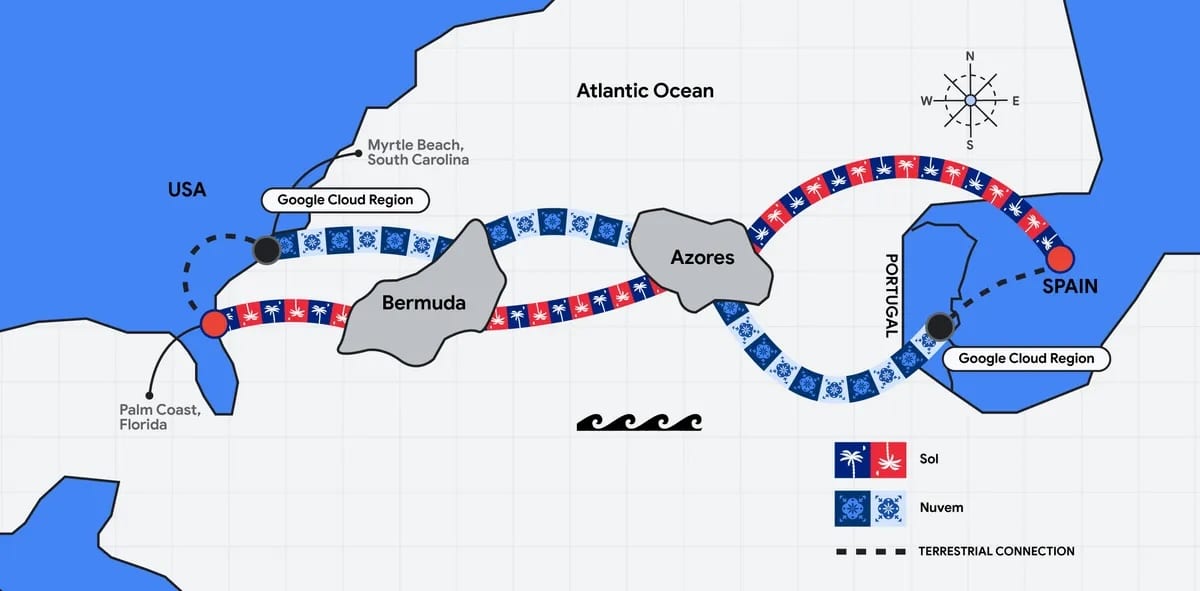Google is once again highlighting Spain as a strategic point for global connectivity. This week, the company announced Sol, its new transatlantic submarine cable that will connect Santander, Spain, with Florida, USA, passing through Bermuda and the Azores. This marks another step in its ambitious deployment of next-generation digital infrastructure.
This cable will be the second Google link directly connecting the United States with Spain, following the already operational Grace Hopper, which landed in Sopelana, Bilbao, in 2021. The difference is that Sol will be the only active cable between Europe and Florida, opening new connectivity routes with lower latency, increased capacity, and redundancy.
The aim of this deployment is clear: the explosion of artificial intelligence and cloud services is driving the demand for critical infrastructure. Google states that Sol will help meet the growing needs of Google Cloud and AI services. It’s no coincidence that this announcement comes just months after the company warned about the significant energy and connectivity consumption involved in using its generative models.
According to Google, Sol will enhance the capacity and reliability of its global network across 42 cloud regions, with a particular focus on infrastructure connecting Europe, North America, and emerging Atlantic nodes.
On the Spanish side, the cable will land on the coast of Santander, supported technically by Telxius, a submarine cable service provider belonging to Grupo Telefónica. The city’s mayor, Gema Igual, described the decision as “a golden opportunity to attract technological investment, create jobs, and position Santander as a city ready for telecommuting and advanced services.”
This isn’t just symbolic: cables like this usually foster surrounding tech ecosystems, much like Bilbao did after Grace Hopper’s arrival, attracting data centers and startups seeking ultra-fast connectivity.
On the other side of the Atlantic, Sol will connect at Palm Coast, Florida, where Google will partner with DC Blox to build a landing station, allowing further expansion of its infrastructure. From there, a terrestrial route will carry data to Google’s cloud region in South Carolina.
Both the Florida government and the governments of the Azores and Bermuda have expressed enthusiasm, highlighting the project’s potential to boost regional digital economies. Artur Lima, Vice President of the Azores Government, said: “Google aims to make our islands a strategic node of digital connectivity in the North Atlantic. It’s a vision we fully share.”
The cable’s name, “Sol,” symbolizes not just its origin in warm lands but also its role as a source of light and connection in the global internet network.
Although invisible to most users, submarine cables carry over 95% of the world’s internet traffic. They form the physical skeleton that enables videos, emails, gaming, AI, and all digital services to operate seamlessly.
Projects like Sol, Nuvem, Firmina, and Equiano not only improve the experience of Google’s own services but also consolidate its control over a vital part of the global digital infrastructure. These cables provide redundancy (if one fails), lower latency (faster response times), and greater capacity (more data at once)—all critical for AI applications, video conferencing, and distributed computing.
Spain is increasingly positioning itself as a digital hub for southern Europe, reinforced by installations like Sol. Factors contributing to this growth include:
- Its advantageous geographical location
- Political and regulatory stability
- The expanding ecosystem of data centers and neutral networks in regions such as Madrid, Aragón, and the Basque Country
- And now, Cantabria
The Google Cloud region inaugurated in Madrid in 2022 is strengthening its integration and capacity, establishing itself as a major cloud node on the continent.
Highlight statements include:
- Gema Igual, Mayor of Santander: “This infrastructure will attract talent, investment, and jobs. It’s a decisive step for our city as a Smart City.”
- Mario Martín, CEO of Telxius: “This milestone enhances transatlantic connectivity with greater capacity and resilience.”
- J. Alex Kelly, Florida Secretary of Commerce: “Florida leads the expansion of digital infrastructure. Our collaboration with Google is strategic for our future.”
- Miguel Pinto Luz, Portugal’s Minister: “Sol will strengthen Europe’s digital resilience and addresses the growing technological demand.”
Overall, the announcement of Sol represents more than a technical upgrade; it’s a long-term strategic commitment to global connectivity, regional economic development, and the democratization of AI.
Spain, especially Santander, now claims a position on the Atlantic’s major digital hubs map, in a competition where infrastructure is everything. In the new AI economy, data travels under the sea… and whoever controls these pathways will also shape the future.
Source: blog.google

